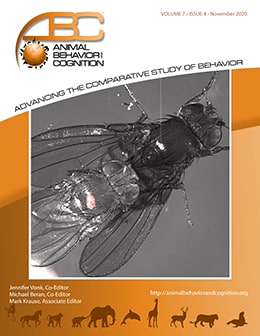Vol 7, Issue 4, November 2020
Preregistered Report: The Effects of Marking Methodology on Mate Choice in Drosophila melanogaster
Citation
Tysall, E. E., Pembury Smith, M. Q. R., & Gilman, R. T. (2020). The effects of marking methodology on mate choice in Drosophila melanogaster. Animal Behavior and Cognition, 7(4), 492-504. doi: https://doi.org/10.26451/abc.07.04.02.2020
Abstract
Mate choice is an important source of sexual selection and a key driver of evolutionary processes including adaptation and speciation. Drosophila species have become an important model system for studying mate choice in the lab. Mate choice experiments often require the marking of individual flies to make those flies identifiable to experimenters, and several marking methods have been developed. All of these methods have the potential to affect mating behavior, but the effects of different marking methods have not been systematically quantified and compared. In this experiment, we quantified and compared the effects of five marking methods commonly used for Drosophila melanogaster: wing clipping, applying paint to the thorax, applying marker pen to the wing, dusting flies with fluorescent powder, and dyeing flies by allowing them to ingest food coloring. Females mated with unmarked males more often than they mated with marked males, but we could not detect significant differences among marking methods. Latency to mate differed among marking methods, and also with the time of day and the time within the trial. We discuss how our results can help researchers plan studies that require the marking of Drosophila.
Keywords
Mate choice, Drosophila, Marking, Methods
